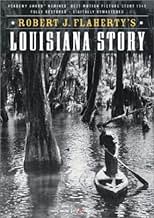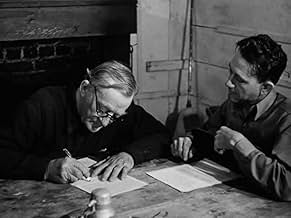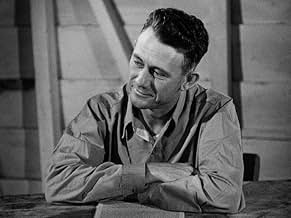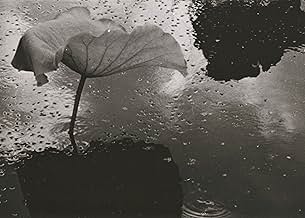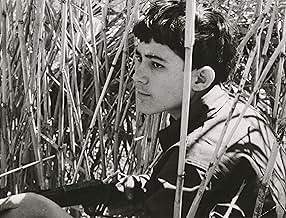VALUTAZIONE IMDb
6,4/10
2293
LA TUA VALUTAZIONE
Aggiungi una trama nella tua linguaThe idyllic life of a young Cajun boy and his pet raccoon is disrupted when the tranquility of the bayou is broken by an oil well drilling near his home.The idyllic life of a young Cajun boy and his pet raccoon is disrupted when the tranquility of the bayou is broken by an oil well drilling near his home.The idyllic life of a young Cajun boy and his pet raccoon is disrupted when the tranquility of the bayou is broken by an oil well drilling near his home.
- Regia
- Sceneggiatura
- Star
- Candidato a 1 Oscar
- 4 vittorie e 3 candidature totali
Recensioni in evidenza
Having lived many years in Acadiana, I can tell you that this is a beautiful depiction of the immense grace of the area during the forties. The film is not great drama, but the mystery and immense beauty of the bayou is authentic. Joseph Boudreaux, the boy in the movie will melt your heart with his lovely presence and Cajun ways.
Thankfully, this film was placed in the archives of the National Library of Congress in the nineties. The restoration is exquisite! I, for one, am thankful that this monumental tribute to the true Cajun people, as they once were, has been resurrected.
Much of what you will see in this film is, sadly, gone forever. There will never be another tribute to Acadiana like Louisiana Story!
Thankfully, this film was placed in the archives of the National Library of Congress in the nineties. The restoration is exquisite! I, for one, am thankful that this monumental tribute to the true Cajun people, as they once were, has been resurrected.
Much of what you will see in this film is, sadly, gone forever. There will never be another tribute to Acadiana like Louisiana Story!
10bandw
If you appreciate black and white cinematography, then you will delight in seeing the restored version of this movie on DVD. Cinematographer Richard Leacock and director Flaherty have teamed up to be the Ansel Adams of the film world. This is one of the most cinematic of films - its power and magic lie in the poetry of the images. The score by Virgil Thomson deserved its Pulitzer Prize for music in 1949; it receives a first class performance here by the Philadelphia Orchestra under Eugene Ormandy.
Some have commented on the weak story, but I rather enjoyed it - it could be billed as "Huckleberry Finn meets Standard Oil." The story is told through the eyes of a young Cajun who lives with his grandfather and mother in a simple cabin in the Louisiana marshland. In the opening shots we see the boy exploring the bayous in his canoe with his pet raccoon. He has an elemental bond with his natural environment that made me jealous. The boy's grandfather signs a lease allowing Humble Oil to drill a wildcat well on the bayou near his cabin. We share the boy's wonder at seeing the oil derrick being floated into position and his excitement in being invited onto the rig to follow the drilling up close.
From the viewpoint of a more environmentally conscious time some sixty years later, the benevolent portrayal of the oil industry seems a bit quaint, but that a young boy should be fascinated by the process seems genuine, in any era. In fact I found the details on the drilling captivating, particularly the way those scenes were filmed as a ballet with the roustabouts moving to the rhythms of their work accompanied by the clanking of pipes and chugging of engines.
I had a problem with how delighted the grandfather and mother were at being able just to buy a few gifts from the profits of oil having been struck on their land. While the company to whom they had leased their land was making mucho bucks, it looks like the family got a few hundred dollars. Given the fact that this movie was commissioned by Standard Oil, I am sure that it was not the intent to make the company appear so greedy, but maybe that's one thing that hasn't changed in sixty years.
Joseph Boudreaux as the young boy is endearing and Lionel Le Blanc is believable as the crusty grandfather. All the actors appear to be locals - this adds authenticity, but also presents a problem in that they are not greatly skilled when it comes to delivering their lines. But there is minimal dialog and what there is is hardly necessary as the music and images carry you along.
The DVD has several interesting extras, one of them being a reading of some letters from Richard Leacock (postmarked from Abbeville, Louisiana) to his wife during the long filming. In one letter he says that they ran across the twelve-year-old Boudreaux in a café in Cameron, Louisiana. He had an Acadian accent, had trapped with his father, could handle a Cajun pirogue, and had an infectious smile. They figured he was perfect for the part but, since he was born out of wedlock and under-aged, there were significant difficulties under Louisiana law to be worked out before he could be signed on. Leacock's letters are quite frank. In one he notes that there was buzz about the visit from the director of all Standard Oil public relations and that Flaherty did not like him, referring to him as "the old bastard."
This is a wonderful film in the literal sense of the word wonderful.
Some have commented on the weak story, but I rather enjoyed it - it could be billed as "Huckleberry Finn meets Standard Oil." The story is told through the eyes of a young Cajun who lives with his grandfather and mother in a simple cabin in the Louisiana marshland. In the opening shots we see the boy exploring the bayous in his canoe with his pet raccoon. He has an elemental bond with his natural environment that made me jealous. The boy's grandfather signs a lease allowing Humble Oil to drill a wildcat well on the bayou near his cabin. We share the boy's wonder at seeing the oil derrick being floated into position and his excitement in being invited onto the rig to follow the drilling up close.
From the viewpoint of a more environmentally conscious time some sixty years later, the benevolent portrayal of the oil industry seems a bit quaint, but that a young boy should be fascinated by the process seems genuine, in any era. In fact I found the details on the drilling captivating, particularly the way those scenes were filmed as a ballet with the roustabouts moving to the rhythms of their work accompanied by the clanking of pipes and chugging of engines.
I had a problem with how delighted the grandfather and mother were at being able just to buy a few gifts from the profits of oil having been struck on their land. While the company to whom they had leased their land was making mucho bucks, it looks like the family got a few hundred dollars. Given the fact that this movie was commissioned by Standard Oil, I am sure that it was not the intent to make the company appear so greedy, but maybe that's one thing that hasn't changed in sixty years.
Joseph Boudreaux as the young boy is endearing and Lionel Le Blanc is believable as the crusty grandfather. All the actors appear to be locals - this adds authenticity, but also presents a problem in that they are not greatly skilled when it comes to delivering their lines. But there is minimal dialog and what there is is hardly necessary as the music and images carry you along.
The DVD has several interesting extras, one of them being a reading of some letters from Richard Leacock (postmarked from Abbeville, Louisiana) to his wife during the long filming. In one letter he says that they ran across the twelve-year-old Boudreaux in a café in Cameron, Louisiana. He had an Acadian accent, had trapped with his father, could handle a Cajun pirogue, and had an infectious smile. They figured he was perfect for the part but, since he was born out of wedlock and under-aged, there were significant difficulties under Louisiana law to be worked out before he could be signed on. Leacock's letters are quite frank. In one he notes that there was buzz about the visit from the director of all Standard Oil public relations and that Flaherty did not like him, referring to him as "the old bastard."
This is a wonderful film in the literal sense of the word wonderful.
The opening scenes paint an idyllic picture of nature as well as the relationship it shares with people. With vegetation reflected off the surfaces of ponds, animals roaming about, and the sounds of nature in the background, the bayou feels like a slice of heaven. Even the people who occupy this land don't disrupt the environment since they appear to be one with nature. This is until we're introduced to the threat of industrialization. It starts with the boy (he's referred to as Alexander in the opening, but he's credited as "The Boy" in the film) being knocked into the water due to the wake of a motorboat. We then see an oil tower poking through some trees in the background. The interference of industrialization keeps spiraling until we're introduced to an oil well. With smog being released from its exhaust pipes and the sounds of its machinery being audible throughout much of the bayou, it seems out of place and sacrilegious.
The more one watches the film though, it becomes readily apparent that we're watching a glorification of the oil industry since the film refuses to properly acknowledge the problems it causes to the bayou. You're clearly asked to support the oil well, but given the glaring issues it causes (in addition to the real-world negative effects oil drilling has on the environment), this puts the film at odds with itself. Coming mainly from the perspectives of the working man and those impacted by the oil well, the potential for a great critique on industrialization is there, but we're instead left with an incongruity between the depiction and the endorsement of the industry. Flaherty was commissioned by Standard Oil to make the film though, so it's no surprise that it's propaganda.
The best parts of the film concern the boy's trials within the bayou. As idyllically shot as the bayou is, we're constantly reminded of the danger some of the wildlife poses, specifically in regards to an alligator which recurs throughout the film. Its scenes are memorable, with the standout being a middle scene where the boy attempts to catch it. That scene is tense, but Flaherty was undoubtedly a madman when shooting it. Boudreaux's and the alligator's scenes weren't recorded separately or anything. Rather, they were in fairly close proximity to each other, thus putting Boudreaux in actual danger when that scene was shot. As a result, the suspense in that sequence concerns worrying about real-life harm coming to the actor. To be clear, I don't approve of this as it's clearly child endangerment, but on a gut level, it made for a certain kind of thrill which left a visceral impact on me.
Overall, it's fairly interesting and I enjoyed it in some respects, but the propagandistic elements made it feel like a missed opportunity.
The more one watches the film though, it becomes readily apparent that we're watching a glorification of the oil industry since the film refuses to properly acknowledge the problems it causes to the bayou. You're clearly asked to support the oil well, but given the glaring issues it causes (in addition to the real-world negative effects oil drilling has on the environment), this puts the film at odds with itself. Coming mainly from the perspectives of the working man and those impacted by the oil well, the potential for a great critique on industrialization is there, but we're instead left with an incongruity between the depiction and the endorsement of the industry. Flaherty was commissioned by Standard Oil to make the film though, so it's no surprise that it's propaganda.
The best parts of the film concern the boy's trials within the bayou. As idyllically shot as the bayou is, we're constantly reminded of the danger some of the wildlife poses, specifically in regards to an alligator which recurs throughout the film. Its scenes are memorable, with the standout being a middle scene where the boy attempts to catch it. That scene is tense, but Flaherty was undoubtedly a madman when shooting it. Boudreaux's and the alligator's scenes weren't recorded separately or anything. Rather, they were in fairly close proximity to each other, thus putting Boudreaux in actual danger when that scene was shot. As a result, the suspense in that sequence concerns worrying about real-life harm coming to the actor. To be clear, I don't approve of this as it's clearly child endangerment, but on a gut level, it made for a certain kind of thrill which left a visceral impact on me.
Overall, it's fairly interesting and I enjoyed it in some respects, but the propagandistic elements made it feel like a missed opportunity.
10Huron
Robert Flaherty had a great eye for the interesting shots. Never more so than this oil company funded film about a young boy seeing the oil rig come to his Louisiana bayou. Although there is not much of a story the shots of the oil rig, life in the bayou, and the moods that Flaherty captures make it a film well worth seeing. If you see "Man of Aran" or "Nannok of the North" remember it was the same great documentary filmmaker. I've seen it twice and probably will see it again someday.
10tavm
Under the heading "Louisiana" I checked this documentary called Louisiana Story by Robert J. Flaherty out of curiosity from my local East Baton Rouge Parish Library. Beautiful views of the state swamps as well as fascinating scenes of the oil rig that inhabits them dominates the film which depicts the adventures of a Cajun boy on a boat fishing and hunting alligators with his pet raccoon. His father occasionally comes along for the ride and they both have friendly relations with the workers of the oil well. There are some scenes of the mother as well. Great Pulitzer Prize-winning music scored by Virgil Thomson is beautifully performed by The Philadelphia Symphony Orchestra as conducted by Eugene Ormandy. Wonderful cinematography by Richard Leacock. Worth checking out as a depiction of late '40s Louisiana as well as the final film of Mr. Flaherty before his death in 1951. Update-4/29/07: The Cajun boy that starred in this film, J.C. Boudreaux, is now 73 and lives with his wife of 55 years, Regina, in a FEMA trailer in the town of Sweet Lake which is south of Lake Charles. They moved there after Hurricane Rita destroyed their home in Cameron. They had seven children who have provided them numerous grand-and great-grandchildren. Boudreaux still loves fishing. I found this out reading this morning's The (Baton Rouge) Advocate.
Lo sapevi?
- QuizStandard Oil of New Jersey (became Exxon in 1972 and Exxon/Mobil in 1999) contributed $258,000 to the film's production. Although the company had no rights and no identification in the film, it stood "to get across the idea that oil companies are beneficently public-spirited, their employees honest, industrious and amiable, and their operations productive and innocuous." According to a modern source, Robert J. Flaherty's contract with Standard Oil insured that all of the film's profits went to him. The only connection was that Humble Derrick No. 1 is mentioned - and the Humble Oil Co. was 50% owned by Standard Oil of New Jersey at the time.
- BlooperIn the opening sequence, when The Boy first spots the raccoon, his hair is neat. Then it's mussed. Then it's neat again.
- ConnessioniFeatured in Studies for Louisiana Story (1965)
I più visti
Accedi per valutare e creare un elenco di titoli salvati per ottenere consigli personalizzati
- How long is Louisiana Story?Powered by Alexa
Dettagli
Botteghino
- Budget
- 258.000 USD (previsto)
- Tempo di esecuzione1 ora 18 minuti
- Colore
- Proporzioni
- 1.37 : 1
Contribuisci a questa pagina
Suggerisci una modifica o aggiungi i contenuti mancanti

Divario superiore
By what name was I racconti della Louisiana (1948) officially released in India in English?
Rispondi
